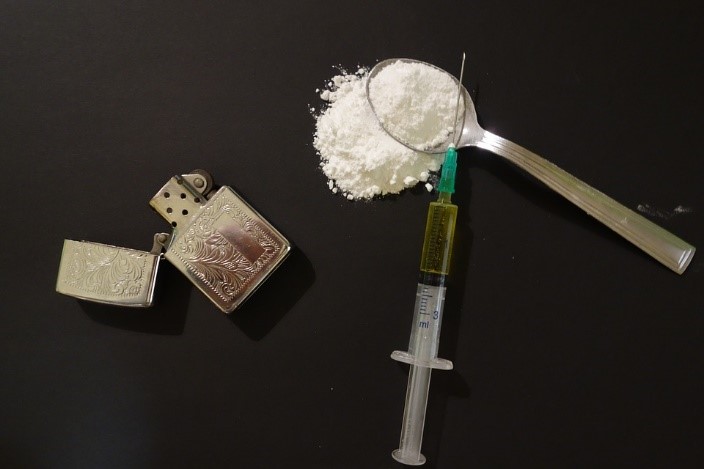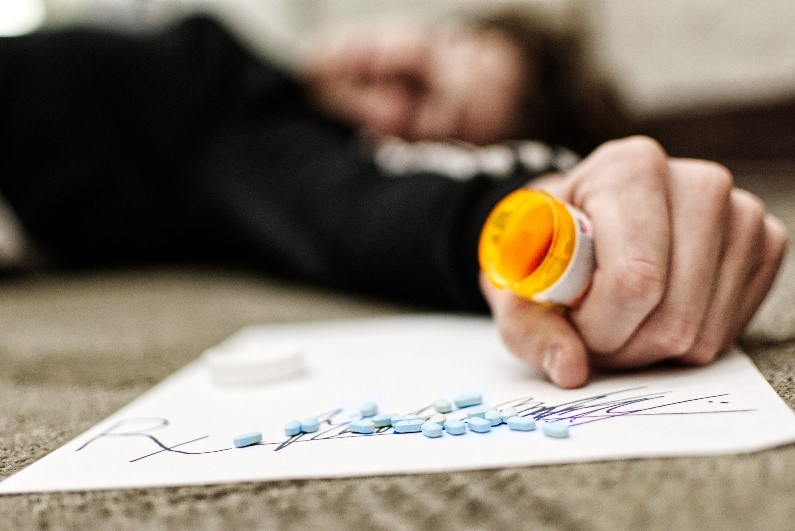Drug overdoses
Problematic use of alcohol and psychoactive substances poses a significant risk, leading to premature death and a decrease in disability-adjusted life years. In Norway, there were 321 reported overdose deaths in 2022. On average, between 2010 and 2022, the yearly number hovered around 280, resulting in a death rate of 5.6 per 100,000. Opioids, which are drugs similar to morphine, accounted for 80-90% of these overdose deaths. In the United States of America alone, the number of opioid overdose deaths reached nearly 50,000 in 2019, which is more than double the death toll in 2010. The majority of these tragic incidents involved fentanyl and its equivalents. It is crucial to prevent a similar situation from occurring in Norway.
Our research on overdose deaths relies heavily on a combination of data from the Norwegian Cause of Death Registry (NoCDR) and the forensic toxicology database of Oslo University Hospital. These sources provide valuable information about the cause of death and drug findings in biological samples obtained during autopsies. By merging these registries, we can determine which drugs were involved in the poisoning and subsequent fatality. Given that multiple drugs are often involved in these cases, accurately identifying the specific drug responsible or contributing to mortality is of utmost importance. While the NoCDR primarily utilizes aggregated codes rather than individual drug-specific codes for cause of death classification, we supplement this information with comprehensive forensic toxicological data. This approach allows us to examine trends related to specific drugs over time, providing a more comprehensive understanding of the situation. From the standpoint of prevention, understanding the drugs that contribute to lethal overdoses is crucial.
The primary objectives of overdose research are to identify risk factors for mortality, and we have more specific aims outlined as follows:
- Determine the drugs involved in drug-related deaths in Norway, focusing on how their prevalence has changed over time in relation to age, sex, and year of death (time trends).
- Investigate the associations between contact with healthcare services, ambulance services, diseases, and drug-related deaths.
- Explore the associations between medically or illegally acquired drug use, diseases, and deaths, with a particular focus on whether certain drugs contribute to a higher number of deaths related to prescription use compared to other medical drugs.
- Identify variations in drug findings and concentrations between non-fatal opioid overdoses and fatal opioid overdoses.

Photo: Pixabay
Funding
Overdose research at the Department of Forensic Sciences, OUH, is a permanent assignment based on funding from the Ministry of Health and Care Services. In addition, the Norwegian Directorate of Health has provided funding on targeted overdose research projects.
Ongoing projects
Drug related deaths in a large registry based study
The fundamental overdose research utilizes data from the Norwegian Cause of Death Registry (NoCDR) and the forensic toxicology database of Oslo University Hospital. This data is crucial in identifying the specific drugs and drug concentrations present in individuals who have passed away due to different underlying causes of death. In order to enhance our understanding of overdose fatalities, this project aims to gather additional data from various health registries. This additional data will provide insights into the diagnoses and healthcare services accessed by individuals prior to their demise.
Moreover, by combining the available data with the Norwegian Prescription Database (NorPD), we can determine whether the detected drugs were obtained through valid prescriptions or through illegal means.
To obtain a comprehensive understanding of the factors that contribute to overdose deaths, this project will also incorporate a control group. The control group will be selected from the National Population Register, allowing us to identify the specific factors that increase the risk of overdose mortality.

Photo: Pixabay
Previous projects
- Overdoses in the Nordic Countries 1984/85, 2007, 2012, 2017, 2022
- Opioid related deaths in Norway 2000-2017
- Overdoses in patients receiving opioid maintenance treatment
- GHB-, fentanyl- and oxycodone related deaths
- Opioid related deaths 2000-2019
- MDMA related deaths
- Non-fatal overdoses
Project members
- Hilde Marie Erøy Edvardsen (Group leader, PhD)
- Stig Tore Bogstrand (Professor, Head of Research, PhD)
- Armika Nyman (Scientist, MSc. Pharm.)
- Thomas Olsen (Scientist, PhD)
- Gudrun Høiseth (Head of Research, MD, PhD)
- Ragnhild Gjulem Jamt (Scientist, PhD)
- Stine Marie Havig (MD)
Past members
- Vigdis Vindenes (MD, PhD)
- Torill Tverborgvik (PhD)
- Per Trygve Normann (PhD)
- Svetlana Konstantinova-Larsen (PhD)
- Asbjørg S. Christophersen (Prof. em.)
Collaboration
- Thomas Clausen (Professor), Norwegian Centre for Addiction Research (SERAF), University of Oslo, Oslo, Norway
- Svetlana Skurtveit (Professor), Norwegian Institute of Public Health, Oslo, Norway; University of Oslo, Oslo, Norway
- Eline Borger Rognli (Senior Scientist), Division of Mental Health and Addiction, Oslo University Hospital, Oslo, Norway
- Kirsten Wiese Simonsen (Forensic Chemist, PhD), Department of Forensic Medicine, Faculty of Health Sciences, University of Copenhagen, Copenhagen, Denmark
- Pirkko Kriikku (Forensic Toxicologist, PhD), Forensic Toxicology Unit, Finnish Institute for Health and Welfare; Department of Forensic Medicine, University of Helsinki, Helsinki, Finland.
- Gunilla Thelander (Chemist), Department of Forensic Genetics and Forensic Toxicology, National Board of Forensic Medicine, Linköping, Sweden
- Svava Thordardottir (Senior Researcher), Department of Pharmacology and Toxicology, University of Iceland, Reykjavik, Iceland.
- Charlotte Uggerhøj Andersen (MD, PhD), Department of Forensic Medicine, University of Aarhus, Aarhus, Denmark.
- Anna Jönsson (Forensic Toxicologist), Department of Forensic Genetics and Forensic Toxicology, National Board of Forensic Medicine, Linköping, Sweden.
- Joachim Frost (Associate Professor), Department of Clinical Pharmacology, St. Olavs Hospital - Trondheim University Hospital, Trondheim, Norway.
- Dorte Christoffersen (Head of Section, PhD), Section of Forensic Toxicology, Departmen of Forensic Medicine, Faculty of Health Sciences, University of Southern Denmark, Odense, Denmark.
- Gerd Jorunn Møller Delaveris (Head of Section, PhD), Department of Forensic Sciences, Oslo University Hospital, Oslo Norway; Institute of Forensic Medicine, University of Oslo, Oslo, Norway.
- Ilkka Ojanperä (Professor), Department of Forensic Medicine, University of Helsinki, Helsinki, Finland; Forensic Toxicology Unit, Finnish Institute for Health and Welfare, Helsinki, Finland.
Press and Media Reports
- Heroinoverdoser – hva skjuler seg bak tallene? Er det rene heroinoverdoser som tar liv i Norge?
- Obduksjon avslører trender i rus- og legemiddelinntaket vårt
- Kommer opioidepidemien til Norge?
- FENTANYLDERIVATER – EN NY OG FARLIG RUSGIFTTREND
- Flere i Norge dør med MDMA i blodet (forskning.no)
If you have questions about the project or suggestions for research collaboration, please contact: Hilde Erøy Edvardsen (himlun@ous-hf.no) at the Department of Forensic Sciences, Section of Drug Abuse Research, Oslo University Hospital, Oslo, Norway.
Publications
Fatal poisonings in Nordic countries in 2022 among people who use drugs
Forensic Science International: Reports, 11, 100408
PublikaID 538
Toxicological findings in overdose suicides 2016-21
Tidsskr Nor Laegeforen, 145 (2)
DOI 10.4045/tidsskr.23.0836, PubMed 39932090
Edvardsen HME, Aamodt C, Bogstrand ST, Krajci P, Vindenes V, Rognli EB (2022)
Concentrations of psychoactive substances in blood samples from non-fatal and fatal opioid overdoses
Br J Clin Pharmacol, 88 (10), 4494-4504
DOI 10.1111/bcp.15365, PubMed 35470456
Jamt REG, Edvardsen HME, Middelkoop G, Kallevik AS, Bogstrand ST, Vevelstad MS, Vindenes V (2022)
Deaths associated with MDMA in the period 2000-2019
Tidsskr Nor Laegeforen, 142 (8)
DOI 10.4045/tidsskr.21.0547, PubMed 35635429
Edvardsen HME, Clausen T (2022)
Opioid related deaths in Norway in 2000-2019
Drug Alcohol Depend, 232, 109281
DOI 10.1016/j.drugalcdep.2022.109281, PubMed 35042099
Langberg C, Hadley CL, Midtrevold M, Edvardsen HME, Molden E, Shafiei M, Jacobsen D (2021) Quetiapine Poisoning – Epidemiology, Toxicokinetics and Review of the Literature
Lupine Online Journal of Medical Sciences
Quetiapine Poisoning – Epidemiology, Toxicokinetics and Review of the Literature (lupinepublishers.com)
Bech AB, Clausen T, Waal H, Vindenes V, Edvardsen HME, Frost J, Skeie I (2020)
Post-mortem toxicological analyses of blood samples from 107 patients receiving opioid agonist treatment: substances detected and pooled opioid and benzodiazepine concentrations
Addiction, 116 (4), 845-855
https://doi.org/10.1111/add.15211, PubMed 32738014
Simonsen KW, Kriikku P, Thelander G, Edvardsen HME, Thordardottir S, Andersen CU, Jönsson AK, Frost J, Christoffersen DJ, Delaveris GJM, Ojanperä I (2020)
Fatal poisoning in drug addicts in the Nordic countries in 2017
Forensic Science International, 313, 110343
https://doi.org/10.1016/j.forsciint.2020.110343, PubMed 32563797
Edvardsen HME, Tverborgvik T, Frost J, Rogde S, Morild I, Waal H, Clausen T, Slørdal L, Vindenes V (2017)
Differences in combinations and concentrations of drugs of abuse in fatal intoxication and driving under the influence cases
Forensic Science International, 127-33
https://doi.org/10.1016/j.forsciint.2017.10.045, PubMed 29128652
Simonsen KW, Edvardsen HME, Thelander G, Ojanperä I, Thordardottir S, Andersen LV, Kriikku P, Vindenes V, Christoffersen D, Delaveris GJM, Frost J (2015)
Fatal poisoning in drug addicts in the Nordic countries in 2012
Forensic Science International, 248,172-80
https://doi.org/10.1016/j.forsciint.2015.01.003, PubMed 25645132
Simonsen KW, Normann PT, Ceder G, Vuori E, Thordardottir S, Thelander G, Hansen AC, Teige B, Rollmann D (2011)
Fatal poisoning in drug addicts in the Nordic countries in 2007
Forensic Science International, 207 (1-3), 170-6
https://doi.org/10.1016/j.forsciint.2010.10.001, PubMed 21036495
Steentoft A, Teige B, Vuori E, Ceder G, Holmgren P, Kaa E, Kristinsson J, Normann PT, Pikkarainen J (1989)
Fatal intoxications in the Nordic countries. A forensic toxicological study with special reference to young drug addicts
Zeitschrift für Rechtsmedizin, 102, 355-365
https://doi.org/10.1007/BF00200244, PubMed 2567559
